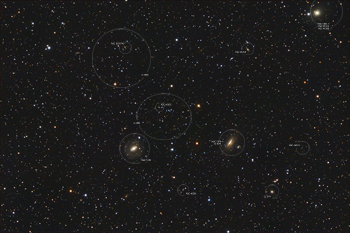 |
CHAMÄLEON + ONJALA OBSERVATORY DeepSky | SITEMAP HOME CHAMÄLEON |
|
 |
|||
| « back to overview Galaxies | Load higher resolution (1800 x 1200 Pixel) (2800 x 1900 Pixel) | Object description |

NGC 5101 and NGC 5078/IC 879
Our image shows another smaller galaxy group in the constellation Water Snake (Hydra). It contains fewer galaxies than the Pavo-I cluster, of which we show an image here. The two main galaxies are NGC 5101 and NGC 5078 and the group has the catalogue number LGG 341 (Lyons Group of Galaxies). The two galaxies are about 80 to 90 million light years away from our solar system. Our image also shows many other fainter and more distant galaxies with many different shapes in the field and additionally two very distant clusters of galaxies, Abell 4804 and Abell 4806.
NGC 5101 is a prime example of a classic barred spiral galaxy with a view directly "from above" the axis of rotation of the galaxy. It is classified as type SB0/a according to Hubble. It is about the size of our Milky Way. Some much more distant background galaxies, e.g. LEDA 158 376, shine through the disk of NGC 5101.
NGC 5078 and IC 879
NGC 5078 interacts with a smaller companion galaxy, catalogued as IC 879, which is located directly below and to the left of the bright core of the larger galaxy. NGC 5078 has a very active core region and we classify it as type Sa according to Hubble. We have a view of the galaxy directly on the edge with the dense dust band. IC 879 is a barred spiral galaxy of Hubble type SBab.
NGC 5101 and NGC 5078 were both discovered by Friedrich Wilhelm Herschel on 28 March 1786. Their true distance is only about 800,000 light years, which is significantly less than half the distance between our Milky Way and the Andromeda galaxy Messier 31.
 |
Abell 4804 and Abell 4806 Abell 4804 and Abell 4806, recognisable in our image by the many small yellowish spots, contains about 40 galaxies, considerably more distant than the group NGC 5101 and NGC 5078. The cluster covers an apparent area about the size of the full moon (0.5 degrees), the 10th brightest galaxy has a magnitude of about 17th magnitude. The distance is not known, but is estimated to be between 500 million and 1 billion light years. Almost no information is available about Abell 4806. It contains only about 10 galaxies, the 10th brightest galaxy also has a magnitude of about 17th magnitude. « Click here here and or on the thumbnail to load a large image with Annotations |
 |
 |
 |
 |
 |
 |
 |
| Sonne | Mond | Sonnensystem | DeepSky | Weitwinkel | Verschiedenes | Spez. Projekte |